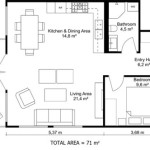How to Get the Floor Plan of a House
Obtaining a floor plan for a house can be beneficial for various reasons. Whether planning a renovation, rearranging furniture, selling or buying a property, or simply wanting a better understanding of the home's layout, knowing the floor plan provides critical information. Several methods are available to acquire this essential document, ranging from readily available resources to more involved processes. This article explores the common and less common approaches to securing a house’s floor plan, outlining the steps, associated costs, and potential challenges involved.
Checking Existing Documentation and Records
The first and often simplest approach to acquiring a floor plan involves exploring existing documentation related to the property. Several potential sources within the home itself or in public records may hold the key to obtaining the desired layout.
Reviewing Homeowner Documents: Start by thoroughly checking any documents provided at the time of purchase. New construction homes frequently come with a set of blueprints or floor plans as part of the closing package. Look for folders, binders, or digital files labeled "House Plans," "Blueprints," or similar titles among your records. These documents often provide detailed layouts, including room dimensions and structural elements.
Checking Mortgage and Appraisal Paperwork: While not always included, mortgage applications and appraisal reports sometimes contain simplified floor plans. These versions might lack the precise details of architectural blueprints but can provide a basic understanding of the room arrangement and overall dimensions. The appraisal, in particular, might include a sketch of the home's layout to support the valuation.
Contacting the Previous Owner or Builder: If the homeowner documents are unavailable or incomplete, reaching out to the previous owner can be a worthwhile step. They may possess copies of the original floor plans or remember where they were stored. For newer homes, contacting the builder or developer responsible for the construction is another viable option. Builders often maintain records of the homes they've built and may be able to provide a copy of the floor plan, possibly for a fee.
Checking Local Government Records: Local government offices, such as the city hall or county recorder's office, are valuable resources for property-related documents. Building permits, filed during construction or renovation projects, often include floor plans as part of the application process. These records are typically accessible to the public, although there may be fees associated with copying or retrieving them. Accessing these records might require a property address or parcel number to facilitate the search.
Consulting the Assessor's Office: The assessor's office, responsible for determining property taxes, may have basic floor plans or sketches on file. These plans are usually less detailed than architectural blueprints but can offer a general overview of the property's layout and dimensions. Public access to assessor’s records varies by jurisdiction, so it's important to check local regulations regarding access before visiting or submitting a request.
If none of these sources contain useful floor plans, consider that the original plans may have been lost, or the house was built before such detailed records were commonly kept. In these cases, other methods may be necessary.
Creating a Floor Plan Manually or Using Digital Tools
If existing documentation proves insufficient, the next step involves creating a floor plan either manually or by leveraging digital tools and software. This approach provides the greatest flexibility in capturing the specific details needed, although it requires careful measurement and attention to accuracy.
Manual Measurement and Sketching: The traditional method involves physically measuring the dimensions of each room using a measuring tape or laser distance measurer. Start by sketching a rough outline of the home's perimeter on paper. Then, measure each room's length and width, noting the positions of doors, windows, and any permanent fixtures like fireplaces or built-in cabinets. Transfer these measurements to the sketch, ensuring proportions are as accurate as possible. Using graph paper can help maintain scale and alignment. This method is cost-effective but can be time-consuming and prone to errors if not executed carefully.
Utilizing Floor Plan Software and Apps: Numerous software programs and mobile apps are designed to simplify the process of creating accurate floor plans. These tools often allow users to input measurements directly into the software, which then automatically generates a visually appealing and scaled floor plan. Some apps even integrate with laser distance measurers to streamline the data input process. Examples of popular floor plan software include AutoCAD, SketchUp, and RoomSketcher. Mobile apps like Magicplan and Floor Plan Creator offer convenient solutions for creating floor plans on a smartphone or tablet. While some of these options are free or offer trial periods, more advanced features typically require a subscription or one-time purchase.
Employing 3D Scanning Technology: For a more precise and efficient approach, consider using 3D scanning technology. Devices like LiDAR scanners, often found in newer smartphones and tablets, can create detailed 3D models of interior spaces. These models can then be converted into accurate floor plans, complete with detailed measurements and architectural features. Although 3D scanning offers significant advantages in terms of accuracy and speed, it may require an investment in specialized equipment or software. Professional 3D scanning services are also available, providing expert assistance in capturing and processing the data.
Regardless of the chosen method, accuracy is paramount. Double-check all measurements and ensure the final floor plan is drawn to scale. Consider employing a professional architect or drafter to review or create the floor plan, particularly for complex layouts or if the plans are intended for official purposes such as permit applications.
Hiring a Professional for Floor Plan Creation
In situations where accuracy is paramount, the layout is complex, or the floor plan is required for official purposes, engaging a professional architect, drafter, or surveyor to create the plan offers the most reliable solution. While this method is generally more expensive than manual measurement or using software, it ensures accuracy, compliance with building codes, and professional-quality results.
Consulting with an Architect: Architects are trained in designing buildings and creating detailed architectural drawings, including floor plans. They can accurately measure the house, create a comprehensive floor plan, and incorporate any desired renovations or modifications into the design. Architects also possess knowledge of building codes and regulations, ensuring the floor plan meets all necessary requirements. The cost of hiring an architect can vary depending on the size and complexity of the project, but it typically ranges from several hundred to several thousand dollars.
Engaging a Drafter: Drafters specialize in creating technical drawings based on sketches, specifications, and calculations provided by architects or engineers. They can accurately translate measurements and design concepts into detailed floor plans, often at a lower cost than hiring an architect. Drafters are proficient in using CAD software and other design tools to create professional-quality drawings. Finding a qualified drafter can be done through online directories, professional organizations, or referrals from builders or contractors.
Hiring a Surveyor: While surveyors primarily focus on property boundaries and land measurements, they can also create floor plans as part of their services. Surveyors use specialized equipment to accurately measure the dimensions of the house and create detailed drawings, including interior layouts. Engaging a surveyor is particularly useful when the floor plan is needed for legal purposes, such as resolving property disputes or obtaining permits for construction projects. The cost of hiring a surveyor for floor plan creation depends on the size and complexity of the property, but it generally falls within a similar range as hiring a drafter.
When selecting a professional, carefully review their qualifications, experience, and portfolio. Ask for references and check online reviews to ensure they have a proven track record of providing accurate and reliable floor plans. Obtain a detailed quote outlining the scope of work, timeline, and associated costs before entering into a contract.
Whether leveraging existing documentation, creating a floor plan manually or digitally, or hiring a professional, acquiring a floor plan for a house is a manageable process. The optimal method depends on individual needs, budget, and the level of accuracy required. By carefully considering the available options and following the steps outlined, obtaining a comprehensive and accurate floor plan can be achieved.

Floor Plan Creator And Designer Free Easy App

9 Ways To Find Floor Plans Of An Existing House Blueprints Archid

House Plans How To Design Your Home Plan

House Plans How To Design Your Home Plan

House Plans How To Design Your Home Plan

Where You Can Buy House Plans Live Home 3d

Floor Plans Types Symbols Examples

How To Properly Read Floor Plans And What Details Look For

Make Your Own Blueprint How To Draw Floor Plans

Floor Plans Types Symbols Examples
Related Posts








